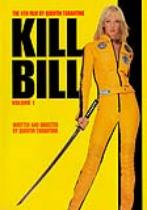Kill Bill Vol. I
 Year:
Year: 2003
Film Studio: Miramax Films, A Band Apart
Genre: Action, Martial Arts
Length: 111 Min.
DirectorQuentin Tarantino
WritingQuentin Tarantino...Writer
Quentin Tarantino ...Original Characters By
Uma Thurman ...Original Characters By
ProducerHarvey Weinstein (1952)
Bob Weinstein (1954)
Erica Steinberg
E. Bennett Walsh
Lawrence Bender (1957)
CinematographerRobert Richardson (1955)
MusicThe RZA ...Composer
StarsUma Thurman as The Bride
Lucy Liu (1968) as O-Ren Ishii
Vivica A. Fox as Vernita Green
Daryl Hannah as Elle Driver
David Carradine (1936) as Bill
Michael Madsen (1958) as Budd
Julie Dreyfus as Sofie Fatale
Chiaki Kuriyama as Gogo Yubari
Review For a new generation of filmmakers, actors and movie fans, Quentin Tarantino has supplanted director Robert Altman in Tinseltown’s version of the
'Emperor’s new clothes'. Whatever this overrated
‘wunderkind’ slops onto celluloid is lauded as the finest form of artistry this side of Michelangelo. Unfortunately for Tarantino, he has started to believe the hype hallowing his persona and each successive movie he makes is even more pretentious and uninspiring than Quentin’s previous film. Which brings me to part one of his chambara
‘opus’,
Kill Bill vol. 1, a visually striking film that is weighted down by its overindulgence in bloodletting and insipid dialogue.
What first struck me about this film was an uncanny resemblance in its visual presentation to Oliver Stone’s bloated bloodbath,
Natural Born Killers. Surreal scenes of senseless violence interspersed with quirky and campy characters dominate the breadth of this films duration. While this concept worked well in
Reservoir Dogs and to a lesser extent in
Pulp Fiction, it now seems as fresh as day old bread. Countless scenes that were
‘sampled’ by the director from his favorite films of the past are re-imagined in his own
‘vision’ to fill out his banal screenplay. Two examples of Tarentino’s penchant for this practice come near the end of the film.
First, after Uma Thurman has beheaded, dismembered or disemboweled almost every yakuza thug in Tokyo, she gives pity to one villain by putting said bad guy over her knee and spanking him with her samurai sword. She then instructs him to go home and he runs away whimpering. Sound slightly familiar, it should, as it is eerily reminiscent of Sanjuro’s handling of the rookie member of one of the gangs he decimates in
Yojimbo. Although he doesn’t spank him with his sword, he spares the young man’s life and instructs him that a long life eating gruel is more desirable than incurring death at such a young age. Yet Tarantino’s version supplants Kurosawa’s dramatic irony with a cheesy moment of subliminal sexual domination by Thurman’s character, which plays well to his audience base of young men and adolescent boys.
The second instance comes in the final showdown between Uma and Lucy Liu just prior to doing battle outdoors in a light snowfall. As they stand apart at opposite ends of the screen and are about to do battle, its déjà vu all over again as Tarantino lifts the showdown scenario from
Samurai Assassin. Whereas Okamoto uses the silence of the snowfall to add tension between the protagonists, and the virginal purity of the blanket of snow to juxtapose the blood that’s about to be spilled, Tarentino inserts snippets of useless hipster dialog to belay the fact that Uma and Lucy are two BMF’s. A good example of this kind of trite verbiage takes place just prior to the showdown, when Liu’s character stares at Uma and quips,
“Silly rabbit”, to which Uma responds, yes you guessed it,
“Trix are for kids.” Maybe Quentin should try his hand at commercials. Just think of all the material he could lift and re-use to pay
‘homage’ to the golden age of advertising. At first I was dumbfounded as to how anyone can believe that QT is a dialogue writing master, and then I nearly doubled up in laughter at how vacuous this exchange came across. But this is what Tarentino has become, cinema’s version of a rap music artist, lifting wholesale fragments of content from quality work by his predecessors and passing it off as an innovated new form of fodder. But because his target audience is in the age demographic of 15 – 25 year old males, most of his fanboys have never seen the original works he’s ripped off and therefore think Tarentino is the Messiah of movie land.
In an interview he did promoting this movie, Tarentino stated that Kill Bill was his version of a yakuza, samurai and spaghetti western all wrapped up in one film. If you’re one of his tunnel vision devotee’s, take the time to delve into the films by the true masters of each genre he’s ripped off. For yakuza films, check out
Branded to Kill or
Youth of the Beast by Suzuki. For samurai flicks, try Okamoto’s
Samurai Assassin,
Sword of Doom or
Kill!, and Kobayashi’s
Samurai Rebellion. For a film with a vengeful female assassin, you only need to watch
Lady Snowblood and you’ve pretty much won’t have to waste your time with this bloated, narcissistic endeavor in comic book cinema.
Ratings Criterion5 Stars - The pinnacle of film perfection and excellence.
4 ½ Stars - Not quite an immortal film, yet a masterpiece in its own right.
4 Stars - Historically important film, considered a classic.
3 ½ Stars - An entertaining film that’s fun or engaging to watch.
3 Stars – A good film that’s worth a Netflix venture.
2 ½ Stars - Borderline viewable.
2 Stars – A bad film that may have a moment of interest.1 ½ Stars – Insipid, trite and sophomoric, and that's its good points.
1 Star – A film so vacuous, it will suck 2 hours from the remainder of your life.
½ Star - A gangrenous and festering pustule in the chronicles of celluloid.